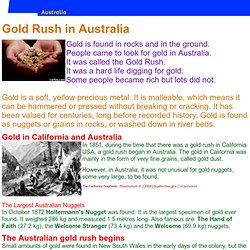

Find, mines, rewards, locations, South Australian Gold Rush. Australian Gold Rush: 1850. The bonanza in California was only the beginning.

An Australian named Edward Hammond Hargraves, who had been there, was certain that the same geological features were to be found in his own country. Returning on the boat from California late in 1850, he predicted that he would find gold within a week. 'There's no gold in the country you're going to and if there is, that darned Queen of yours won't let you touch it,' a fellow passenger told him. 'There's as much gold in the country I'm going to as there is in California,' snapped Hargraves, 'and Her Gracious Majesty the Queen, God bless her, will appoint me one of her Gold Commissioners.' Hargraves was right.
Australian gold rush timeline, HSIE, Discovering gold, Gold! Year 6, NSW. The first major mineral discovery - gold - was a watershed (a turning point or landmark) for Australian society.

The initial stages of the gold rush were responsible for tremendous changes in the community, bringing Australia's first great waves of immigration from countries other than England and Ireland. Ambitious prospectors from Asia, Europe and America made the trek to the goldfields of Ballarat and Bendigo in Victoria, and Bathurst in New South Wales, in the hope of striking it rich. This influx of people brought many social changes, including an increase in racial tensions with the persecution of some groups, notably the Chinese. Government Surveyor James McBrien discovers traces of gold in the Fish River, east of Bathurst. Explorer and geologist Paul de Strzelecki discovers small amounts of gold in silicate near Hartley in the Blue Mountains. The 1840s Early gold discoveries were greeted with fear. Australia's migration history timeline. Era: 1840 - 1900Cultural background: Chinese, EnglishCollection: Powerhouse MuseumTheme:Gold Government Labour Movement Miners Riots Settlement Licence for gold mining, 1853.

Courtesy of the Powerhouse Museum Collection Powerhouse Museum, Sydney, Australia. Object Name Gold Mining Licence. Object/Collection Description Licence for gold mining, framed, paper / wood / glass, issued to J McDonnell, printed by John Ferres, Government Printing Office, Victoria, Australia, 1853. In March 1851, Edward Hargraves wrote to the Sydney Morning Herald to announce that he had found payable gold just outside the New South Wales town of Bathurst. Lambing Flat miners’ camp, c.1860s Courtesy State Library of New South Wales With so many people leaving for the gold fields, many businesses found it hard to keep operating. Although there were some remarkable discoveries on the gold fields, few people made their fortune and most drifted back to towns and cities looking for work.
Bibliography Websites. Gold rush history - Australia's Golden Outback. The Western Australian gold rush began with the first discovery of gold in the late 1890s.

News of the gold spread as fast as the region’s wildfires and soon gold prospectors were arriving to seek their fortune and set up gold rush towns in the dusty landscapes of the Kalgoorlie, Goldfields and Murchison regions. They came slowly at first, but as the finds grew so too did the population. Lonely clusters of tents and rough bough sheds were soon transformed into booming Western Australian gold rush towns. Grand hotels lined the main streets and bustling town centres soon boasted butchers, bakers, schools and churches. And with the completion of the Golden Pipeline, this arid region was given a constant supply of fresh water. Chinese at the Australian Goldfields. Chinese at the Australian Goldfields At the time that news about the Australian goldrush reached China in 1853, the country had been suffering from years of war and famine.

In order to raise money for the fare to Australia, a man would take a loan from a local trader, agreeing to make regular repayments. His wife and children stayed behind, and worked for the trader if the man was unable to repay the money he had borrowed. To reach Melbourne, it was a journey of several months by ship in cramped conditions. A village in China When the Chinese arrived at the goldfields, they stayed together in large teams with a head man in charge. The Australian gold rush. JCF Johnson, A Game of Euchre, col. wood engraving, Australasian Sketcher Supplement [Melbourne], 25 December, 1876.

Image courtesy of the : nla.pic-an8927787. The gold rushes of the nineteenth century and the lives of those who worked the goldfields - known as '' - are etched into our national . There is no doubt that the gold rushes had a huge effect on the Australian economy and our development as a nation. It is also true to say that those heady times had a profound impact on the national psyche. The camaraderie and '' that developed between diggers on the goldfields is still integral to how we - and others - perceive ourselves as Australians. Indeed, mateship and defiance of authority have been central to the way our history has been told. Even today, nothing evokes more widespread national pride than groups of irreverent Aussie 'blokes' beating the English at cricket, or any other sport for that matter!
The discovery that changed a nation Gold frenzy A nation transformed Racism. Gold! Gold Rush in Australia Gold is found in rocks and in the ground.

People came to look for gold in Australia. GoldRush.